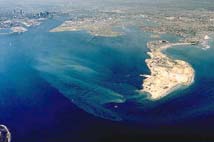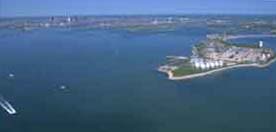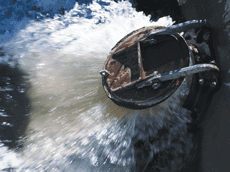1985
The Massachusetts Water Resources Authority (MWRA) assumed
responsibility for Greater Boston's water and sewer systems following the passage of its enabling act in 1984. |
1986
Judge
A. David Mazzone ordered a 13-year schedule to construct the new Deer
Island Treatment Plant (DITP) and related facilities. Until 2004, Judge Mazzone oversaw the design and construction of MWRA's Deer Island Treatment Plant and other major sewer facilities on behalf of the federal court. |
1988
MWRA started disposing of sewage scum in a landfill instead of discharging it into the harbor. Scum removal left less oil, grease, and floating matter in effluent.
MWRA made interim repairs and upgrades to the old DITP including a more reliable disinfection system, thus discharging fewer bacteria in the effluent. Read more about the history of the Deer Island Treatment Plant (pdf).
|
1989
Pumping capacity was about 700 million gallons per
day (mgd) in 1989. This eventually increased to 900 mgd in 1998. More wastewater was treated and combined sewer overflow (CSO) discharges were reduced. |
1991
MWRA stopped discharging sludge into Boston Harbor from the old Deer Island and Nut
Island treatment plants, and began recycling sludge into fertilizer at the Fore River pelletizing plant. Solids discharged to the harbor decreased by 40 dry tons per
day, and there were other corresponding improvements in water quality.
|
1995
The new DITP put into service the first stages of improved primary treatment.There was a drop in total solids discharged, as well as further decreases
in bacteria, Biochemical Oxygen Demand (BOD), Nitrogen and Phosphorous. MWRA releases reports on Boston Harbor watersheds (pdf) and the new Deer Island Treatment Plant (pdf) for the public. |
1997
The first of three batteries of secondary
treatment started up at DITP. The beginning of secondary treatment marked a dramatic decrease
in BOD and a continued improvement in water quality. |
1998
The second battery of secondary treatment started up at DITP. MWRA completed construction of the Inter-island tunnel, which transferred South System flows to DITP from the Nut
Island Treatment Plant (NITP) allowing most flow to receive
secondary treatment. This ended effluent discharges from NITP to the south Harbor. Today, the Nut Island Headworks facility and a park have replaced the old treatment plant. MWRA released a public report on the Boston Harbor Project. |
2000
DITP discharges were diverted to the new Bay outfall, ending discharges into Boston Harbor. Better-treated effluent is now dispersed
through an undersea tunnel and diffusers 9.5-miles out into the deeper waters of Massachusetts Bay, where it is well diluted. MWRA released a public report on the new Massachusetts Bay outfall. (pdf)
|
2001-2005
All batteries of secondary treatment are operating at DITP, optimizing treatment. Secondary facilities are improved. Biosolids are sent to the pelletizer plant to convert to fertilizer. The effluent discharged consistently meets expected standards. Bacteria levels and other pollution indicators have lowered at the previous outfall sites in Boston Harbor.
|
1987-2015
As part of the Boston Harbor Project, MWRA created a long-term plan to reduce combined sewer overflows (CSOs), which discharge a mixture
of stormwater runoff and sewage directly into the harbor during heavy
rainstorms. In the 1980s, CSOs
annually discharged about 3.3 billion gallons of partially treated or raw
combined sewage into the harbor and its tributary rivers. At the completion of the CSO Plan, annual CSO volumes were reduced by over 2.8 billion gallons a year. |
|
Combined Sewer
Overflow (CSO) |
|


